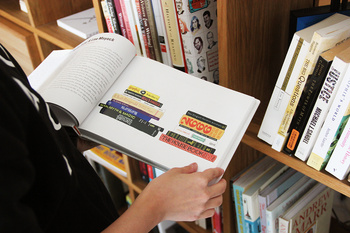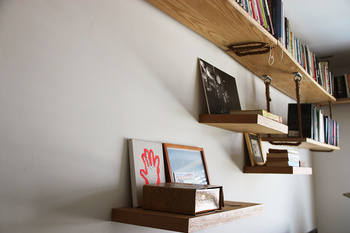A collection of conversations with a diverse range of local and regional creatives
Library Conversations for SGABF2020
We examined the systems that support art book making and independent art book publishing in Singapore and the region.
A Closer Look for SGABF2019
We gathered perspectives on our zine and art book culture, and discuss the possibilities of self-publishing today.
21 Creatives for SGABF2018
We sat down with 21 creatives of various disciplines to learn about their practice and asked each of them to fill up a blank page in a notebook.
REBECCA TOH

Photo Credit: SGABF
SGABF: You are as much a freelance photographer as you are an artist — how do you find a balance between the two?
Rebecca Toh (RT): I don't really think that I am an artist yet, but I want to be. I became a photographer because I wanted to be doing something I like for a career. I have been working very hard for the past four years but it had always been in the commercial realm. So I feel that I have not become the kind of photographer I want to be yet, and that is something that I am actively working on now. I feel like I need to grow as a photographer.
I knew that I would never want a 9-to-5 job, so I had to adjust my attitude. Selling your skills as a craftsman is not a bad thing at all. Once you change your perspective towards that, you can bring something different to the commercial world. Of course, we can all aspire to be like Daido Moriyama who just shoots his own stuff and never anything commercial, but in the meantime maybe some balance is good. If more people change their perspectives, they can do what they want and not be stuck in something they hate.

Photo Credit: SGABF
To me, being an artist is being able to express your own truth. Other people may have their own definition but it is to be able to say the things that I want to say in the way that I want to say it. This truth does not depend on anything external and it does not even have to be correct, but it should be a representation of myself. In a way, it is a mark that I leave in this world. Many people have lived and died without leaving anything behind; not that it is important to leave a legacy, but I would love to know their stories. I was reading Sapiens and it was talking about how there are no records of how people had lived before the agricultural revolution. For me, it is good to create so that people in the future can look back and know how we lived and thought. So art is really important, and maybe everyone is an artist in their own way.
SGABF: Photographers often develop a specific style as a form of signature to their work. Has photographing for commercial clients influenced your style and/or the way you see things?
RT: No! In fact, it is something that I struggle with and push against because when you do commercial work, it is very client-based and driven by what kind of photography will push the product and things like that. So within my commercial work, I feel that it is often very difficult for me to input my own style, and I am still working on that.
I want my personal photography to influence my commercial photography. I think that is the goal of every photographer who does commercial work because you want to bring your vision to the commercial platform. People see you when you work with bigger brands and if you are able to, you can reach out more through your own style.
That will bridge the gap between the artist and the commercial side of you, which is the best of both worlds. I think everyone wants that.
RT: In a way, it is. I am an introvert, but everybody still needs human connection and wants to be connected to other people, so photography is like my passport. When I did the project 4 years ago, I did not know anybody in the industry but people were willing to open their doors with this photo project, rather than if I had just told them that they inspired me and I wanted to talk to them.
That would sound a bit weird, right? [laughs] I love that my camera is an excuse to see the world and to get to know people. There are people who inspire me, make me want to do better, and help me see things that I have never seen before. So in a way, photography is a way for me to be connected to other human beings; it is not something that I want to do in isolation.

RT: They are all extensions of the same “me”. Radio was fun, and it was something that I never thought I would be able to do. I realised that even though I was super terrible at first, I became better in the end. So I learned that it is okay to be a newbie because you will still get opportunities if you put yourself out there.
SGABF: Some of your projects like Creative People + Projects and the interviews on your blog are inspired by your desire to get to know people. Is photography a means for you to do that? What pushes you to start these personal projects?
RT: In a way, it is. I am an introvert, but everybody still needs human connection and wants to be connected to other people, so photography is like my passport. When I did the project 4 years ago, I did not know anybody in the industry but people were willing to open their doors with this photo project, rather than if I had just told them that they inspired me and I wanted to talk to them.
That would sound a bit weird, right? [laughs] I love that my camera is an excuse to see the world and to get to know people. There are people who inspire me, make me want to do better, and help me see things that I have never seen before. So in a way, photography is a way for me to be connected to other human beings; it is not something that I want to do in isolation.

Photo Credit: SGABF
SGABF: You have dabbled in different mediums like radio and writing. How were they different in bringing out your “voice” in comparison to photography? Is there any upcoming project that we should look out for?
RT: They are all extensions of the same “me”. Radio was fun, and it was something that I never thought I would be able to do. I realised that even though I was super terrible at first, I became better in the end. So I learned that it is okay to be a newbie because you will still get opportunities if you put yourself out there.
I believe that all the things we do are extensions of ourselves. We have different sides, and different mediums to help us express those sides. But whatever I do — even though I want to be alone 70 percent of the time — in a way I am just trying to connect with people.

I will be working on my photo book project in Hawaii this July. I have been wanting to do that for a long time, and hopefully, that will happen this year. It will be like a one-person magazine, photo book and travel diary all in one, and it will be very personal and representative of who I am. It will be paired with my writing as well because that is a big part of me; photography can feel limiting sometimes. I am also moving towards filmmaking, so this project will hopefully be a mix of all the things that I want to and can do.
RT: Singapore is very small — although within it we have a lot of talent. Hopefully bringing in more international perspectives can help us see a little bit more of what is out there. We can be inspired by all these people coming in, so having that international slant would be really nice.
It would be good to be able to reach out to more people in Singapore as well because a lot of Singaporeans don't know what is going on in the arts scene. People can understand more about what they are exposed to, and it will be good if we can influence them.
Rebecca Toh (b. 1986) is a photographer and a night-time writer.
www.rebeccatoh.com

Photo Credit: SGABF
I will be working on my photo book project in Hawaii this July. I have been wanting to do that for a long time, and hopefully, that will happen this year. It will be like a one-person magazine, photo book and travel diary all in one, and it will be very personal and representative of who I am. It will be paired with my writing as well because that is a big part of me; photography can feel limiting sometimes. I am also moving towards filmmaking, so this project will hopefully be a mix of all the things that I want to and can do.
SGABF: In your opinion, how do you think Singapore Art Book Fair should be like for artists like you? What should it aim to achieve?
RT: Singapore is very small — although within it we have a lot of talent. Hopefully bringing in more international perspectives can help us see a little bit more of what is out there. We can be inspired by all these people coming in, so having that international slant would be really nice.
It would be good to be able to reach out to more people in Singapore as well because a lot of Singaporeans don't know what is going on in the arts scene. People can understand more about what they are exposed to, and it will be good if we can influence them.
Rebecca Toh (b. 1986) is a photographer and a night-time writer.
www.rebeccatoh.com
© Singapore Art Book Fair 2025. All rights reserved.
For further enquiries, please contact us at info@singaporeartbookfair.org.
Singapore Art Book Fair is organised by

For further enquiries, please contact us at info@singaporeartbookfair.org.
Singapore Art Book Fair is organised by
